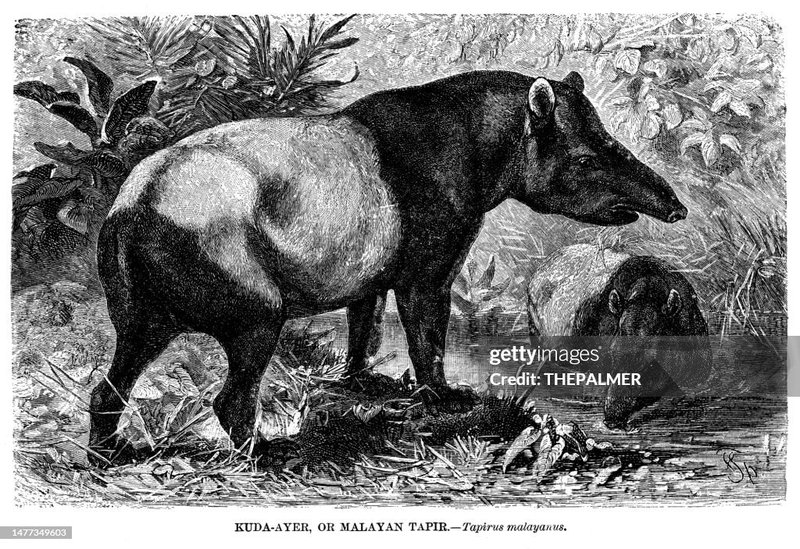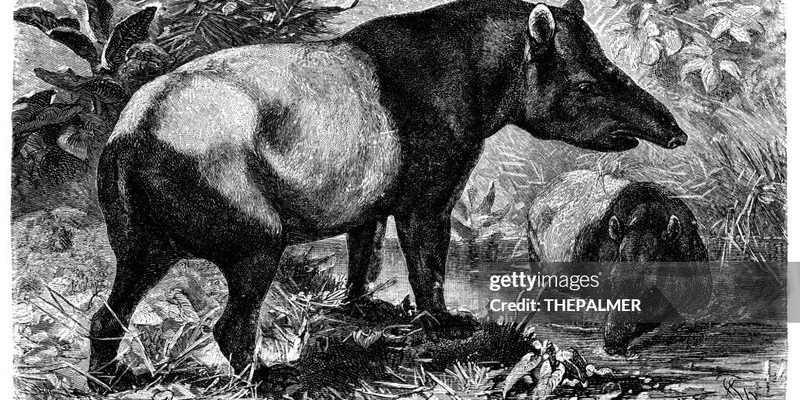
Tapirs belong to a very ancient group of creatures known as perissodactyls, which also includes horses and rhinoceroses. They are often viewed as “living fossils,” hinting at their long and storied past. While these creatures may appear somewhat awkward, they are beautifully adapted to their environment. The Malayan tapir, specifically, is a tropical delight, found in the lush rainforests of Southeast Asia. But there’s much more than meets the eye. In this article, we’ll explore how they evolved through countless environmental changes, going from formidable ancestors to the unique animal we know and love today.
A Glimpse into Tapir Ancestry
To understand the Malayan tapir’s evolution, we need to go back to its ancestors. The modern tapir’s ancestors date back over 50 million years ago. Picture this: ancient forests full of diverse flora and fauna. Back then, tapirs thrived in these rich ecosystems and were similar in body shape to their modern relatives. These early tapirs were quite different, living alongside other mammals that have since gone extinct.
Interestingly, the family tree of tapirs branches out to include Equidae (horses) and Rhinocerotidae (rhinos). The common ancestor of these groups was likely a small, herbivorous animal with a different body structure from what we observe in tapirs today. Over time, as climates and available habitats changed, the tapir adapted to survive. It’s like watching a character evolve in a story. The plot twists of climate change, competition, and food availability shaped their evolution.
Today, there are four species of tapirs, and the Malayan tapir is the largest of them all. It’s important to note that while they share a common ancestor, each species has adapted to its own unique environment. This diversity showcases the beauty of evolution and how survival often means change.
The Unique Features of the Malayan Tapir
Now that we’ve established the ancestral background, let’s focus on the unique characteristics of the Malayan tapir. One of the most striking features is its distinctive coloration. The Malayan tapir has a black and white pattern that helps it camouflage in the dappled light of the forest. Think of it as nature’s very own design—perfectly suited for its habitat.
In addition to its appearance, the Malayan tapir has a long, flexible snout, which serves multiple purposes. This snout functions like a handy tool; it helps them grasp leaves, fruits, and other vegetation as they move through the dense underbrush. Honestly, it’s pretty amazing how such a unique feature has evolved for their survival.
Their size is another fascinating aspect. As the largest tapir species, they can weigh up to 700 pounds! You might think that large size would be a disadvantage in the wild, but it actually helps them deter predators, primarily large cats like tigers. This hefty build, combined with their impressive swimming skills, allows them to thrive in their rainforest environment.
The Role of Climate Change in Evolution
Here’s the thing: tapirs didn’t evolve in a vacuum. They experienced significant shifts in their environment due to climate changes over the millennia. As forests expanded or contracted, tapirs had to adapt. The Malayan tapir, for instance, is a product of tropical forest evolution. This means their adaptations are closely tied to the success of their forest habitat.
During the last ice age, much of Southeast Asia faced drastic changes. Forests shrank, and tapirs were forced to navigate through fragmented habitats. These shifts helped shape their current behaviors and traits. In essence, they had to become resourceful. Those that thrived found new food sources and adapted their lifestyles.
Moreover, as animals like elephants and rhinos evolved, the tapir found its niche. They became browsers, feeding on leaves, fruits, and young branches, which set them apart from their grazing relatives. Essentially, they carved out a role that was uniquely their own, proving that adaptation is key to survival.
Adaptations for Survival
Tapirs are remarkable survivors, thanks to their array of adaptations. Beyond their camouflage and snout, they have a unique digestive system that helps process tough plant materials. Their stomachs are designed to ferment food, breaking it down more effectively than many other herbivores. Just picture a high-tech little factory working hard to extract nutrients!
Furthermore, tapirs possess powerful limbs that enable them to maneuver through dense undergrowth effortlessly. Their strong legs and webbed feet make them excellent swimmers. In fact, tapirs are known to submerge themselves in water for extended periods, allowing them to cool off and evade predators. This ability highlights the balance between evolution and environmental challenges.
Interestingly, tapirs also communicate with one another through a variety of sounds, including whistles and barks. This vocalization helps them stay connected in their often isolated habitats. So, next time you spot a tapir, remember they’re not just wandering around aimlessly; they’re adapting and thriving in their own special way.
The Importance of Conservation
Despite their evolutionary success, Malayan tapirs face several threats today. Habitat destruction due to deforestation, agriculture, and urbanization puts immense pressure on their populations. As their natural habitats shrink, so does their chance for survival. Here’s where conservation efforts come in.
Protecting these unique creatures is vital—not just for the tapirs themselves but for the entire ecosystem they inhabit. Malayan tapirs play a crucial role in their environment; by eating fruits and plants, they help disperse seeds throughout the forest. This makes them integral to forest regeneration and biodiversity.
Various organizations are working hard to protect the Malayan tapir. This includes creating wildlife reserves and promoting sustainable land use practices. These efforts underscore the importance of preserving not just the tapirs but the entire ecosystem they represent.
The evolutionary journey of the Malayan tapir is more than just a story of survival; it’s a fascinating tale of adaptation and resilience. From ancient ancestors to the unique tapirs we see today, their history is a testament to nature’s incredible ability to adapt to changing environments.
As we look toward the future, it’s essential to remember the role we play in protecting these remarkable creatures. By honoring their heritage and supporting conservation efforts, we can ensure that the Malayan tapir continues to thrive in the rainforests of Southeast Asia. So, the next time you think about tapirs, picture not just a peculiar animal but a symbol of evolution, resilience, and the interconnectedness of life on Earth.

